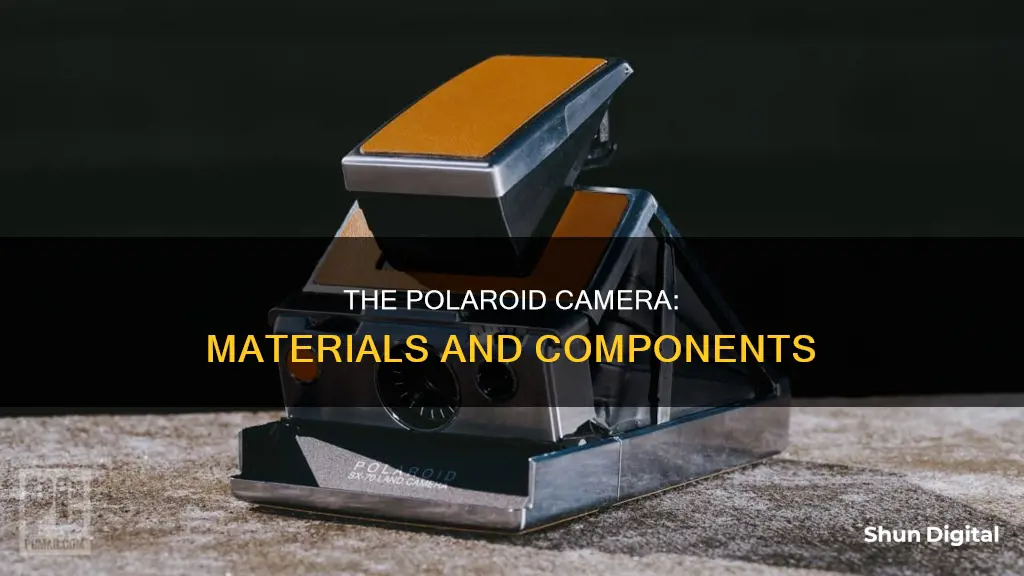
The Polaroid camera is an instant camera that uses self-developing film to create a chemically developed print shortly after taking a picture. The first Polaroid camera, the Land Camera Model 95, was released in 1948 and revolutionised the world of photography by minimising the time between taking a photograph and viewing the image. The camera was invented by Edwin Land, who founded the Polaroid Corporation in 1937. Over the years, Polaroid has released several models of its camera, including the SX-70, which introduced integral print film, and the Polavision, an instant movie camera. Despite facing competition and financial troubles, Polaroid remains a powerful brand in the world of instant photography.
| Characteristics | Values |
|---|---|
| Inventor and founder of Polaroid Corporation | Edwin H. Land |
| Year of invention | 1948 |
| Time taken to develop the first photo | About a minute |
| First colour film | Polacolor film |
| Year of first colour film | 1963 |
| First instant camera | Land Camera Model 95 |
What You'll Learn

The Polaroid Corporation
Edwin Land was a prolific inventor, acquiring over 500 patents during his life. His interest in light and its manipulation through engineering began when he was just 13 years old, playing with the idea of polarizing materials to reduce glare from lights. By the 1930s, he had created synthetic polarised materials for the commercial market.
In 1932, Land partnered with Wheelwright to create the Land-Wheelwright labs to manufacture his polarizers. These were used for filters for existing cameras, glare-free sunglasses, and early 3D images. In 1937, the company incorporated under the name Polaroid, derived from the function of the polarizing material.
During World War II, Polaroid designed and manufactured products for the armed services, including an infrared night-viewing device. After the war, the growth of the American economy allowed new industries to flourish, including instant photography.
The first Polaroid camera, the Land Camera Model 95, was unveiled in February 1947 and released to the public in 1948. The camera held two sheets of photo paper at opposite ends of the interior body. An exterior knob turned a pair of interior rollers, pushing the sheets together and expelling them from the camera. Development chemicals were pressed between the layers, taking about a minute to develop before the layers were peeled apart to reveal the image.
In 1963, Polaroid introduced Polacolor film, allowing instant camera owners to take colour photos for the first time. The negative photo paper had three layers, each sensitive to either blue, green, or red light. Yellow, magenta, and cyan developing chemicals were pressed across the layers, creating a single image.
In 1972, Polaroid released the SX-70, which incorporated colour advancements and integral print film, meaning that users no longer had to peel away layers of film and were handed a fully formed photo.
In 1977, Polaroid released Polavision, an instant movie camera system. However, this product failed to impress consumers and was discontinued after two years.
In the 1980s, Polaroid attempted to shift away from consumer photography, a market in steady decline, and entered the electronic video market. The company was one of the early manufacturers of digital cameras, releasing the PDC-2000 in 1996. However, it failed to capture a large market share in that segment.
In 2001, the original Polaroid Corporation filed for bankruptcy protection and was sold to Bank One's One Equity Partners. The company continued to face financial troubles, filing for bankruptcy again in 2008. In 2009, Polaroid was acquired by PLR IP Holdings LLC, which used the brand to market various products related to instant cameras.
In 2017, PLR IP Holdings was acquired by Polish investor Wiaczesław "Slava" Smołokowski, who also owned the majority shares in the Impossible Project—a company formed to continue producing Polaroid-compatible film. The Impossible Project was rebranded as Polaroid Originals, and in 2020, it became Polaroid.
Wireless Camera Battery Life: How Long Do They Last?
You may want to see also

Edwin H. Land
Edwin Herbert Land was an American scientist, inventor, co-founder of the Polaroid Corporation, and developer of the first instant camera. Born in 1909 in Bridgeport, Connecticut, Land displayed an early interest and aptitude for science and invention. As a child, he was known to take apart household appliances, and as a young man, he studied physics at Harvard College, focusing on optics. However, he left after his freshman year and moved to New York City, where he invented inexpensive filters capable of polarizing light, which he called Polaroid film.
In 1932, Land, along with his Harvard physics professor, George Wheelwright III, founded the Land-Wheelwright Laboratories to commercialize his polarizing technology. The company was renamed the Polaroid Corporation in 1937 and began to produce and sell polarizing filters for various applications, including sunglasses, camera filters, and scientific research.
During World War II, Land contributed to military efforts by developing technology such as dark-adaptation goggles, target finders, smart bombs, and a stereoscopic viewing system for aerial photography. It was during a vacation to Santa Fe, New Mexico, with his three-year-old daughter, Jennifer, that Land conceived of the idea for an instant camera. His daughter's question, "Why can't I see the picture you just took of me?" sparked his interest in creating a camera that could produce photographs instantly.
In February 1947, Land demonstrated the first instant camera, known as the Polaroid Land Camera, to the Optical Society of America. The camera went on sale in late 1948 and revolutionized photography by making it possible to take and develop a picture in 60 seconds or less. The camera was a commercial success, and Land's subsequent innovations in instant photography, such as peel-apart color prints, further solidified Polaroid's dominance in the market.
Land's contributions extended beyond the field of photography, as he made significant advancements in the understanding of color vision and played a crucial role in the development of photographic reconnaissance and intelligence-gathering techniques during the Cold War. He received numerous awards and honors throughout his career, including over 500 patents and various honorary doctorates. He passed away in 1991, leaving behind a legacy of scientific innovation and a company that continues to bear his name.
Prolong Your Camera's Battery Life: Tips and Tricks
You may want to see also

Instant film
The first instant film was unveiled in New York City in 1947, a year before the release of the first instant camera, the Land Camera Model 95. The initial prints were in sepia-tone, with black-and-white prints becoming available in 1950. In 1963, Polaroid introduced Polacolor film, which allowed users to take colour photos for the first time. The film had three layers, each sensitive to either blue, green, or red light, with corresponding developing chemicals pressed across their respective layers.
In the 2000s, sales of analog film dropped by at least 25% per year, and in 2008, Polaroid filed for bankruptcy protection for the second time and announced it would discontinue production of its instant films and cameras. However, the brand and assets were sold, and the new Polaroid company formed, eventually rebranding as Polaroid Originals in 2017 and Polaroid in 2020. Today, Polaroid continues to manufacture instant film for several models of its cameras, including the i-Type, 600, and SX-70.
Charging Your Lumix Waterproof Camera: A Step-by-Step Guide
You may want to see also

The first Polaroid camera
Edwin Land is the inventor behind the Polaroid Corporation and its first instant camera, which was released in 1948. Land was a prolific inventor, acquiring over 500 patents during his life, and his interest in light and its manipulation through engineering led him to develop synthetic polarised materials for the commercial market in the 1930s.
The idea for the first instant camera came about in 1943, when Land's three-year-old daughter, Jennifer, asked to see a picture he had just taken of her. When Land explained the lengthy process of sending the film away to a lab to be developed, Jennifer wondered if it was possible to see the image immediately. This sparked an idea in Land's mind, and he set about building what was essentially a darkroom in a box.
The first Land Camera was unveiled at a meeting of the Optical Society of America in February 1947, and it went on sale to the public in 1948, just in time for Christmas. Despite the high price tag of about $90, the initial run of 50 cameras sold out on the first day.
Camera LED: Why Does It Blink Without a Battery?
You may want to see also

Polaroid's first color film
Edwin Land, the founder of the Polaroid Corporation, developed the first instant camera during World War II. After the war, the growth of the American economy allowed new industries to flourish, including instant photography. The first Polaroid camera, which debuted in 1948, relied on the photographer to time the development of the film, pull out the print to burst a pod of developing chemicals, and peel away the top film. These first film prints were in sepia-tone, followed by black-and-white prints in 1950.
In 1963, Polaroid introduced peel-apart colour prints, marking the first time that Polaroid cameras could capture images in colour. Known as the Polacolor pack film, this innovation involved pulling two tabs from the camera, with the second tab pulling the "film sandwich" through the rollers to create the picture. Working with colour presented new challenges, as the film negative now contained three layers of emulsion that were sensitive to blue, green, and red. Each layer had dye-developing molecules underneath in their complementary colours of yellow, magenta, and cyan. When an emulsion layer is struck by light, the complementary dye below it is blocked, allowing the other dyes to transfer to the positive and combine to create the desired colour.
In 1972, Polaroid introduced integral film, which eliminated the need for photographers to peel apart the positive and negative layers to reveal the photograph. This process was similar to the Polacolor film but with additional timing and layers involved. The film itself integrated all the necessary layers and functionality into the film pack. The SX-70 camera was the first camera to use this type of film.
The Ubiquitous Surveillance Cameras: Made in China?
You may want to see also
Frequently asked questions
The Polaroid camera was made out of synthetic polarised materials, which were created by Edwin Land.
The first Polaroid camera, the Land Camera Model 95, held two sheets of photo paper at opposite ends of the interior camera body. An exterior knob turned a pair of interior rollers which pushed the sheets together before expelling them from the camera.
The Polaroid camera was invented to develop film internally, allowing the user to hold the finished photograph in their hand almost instantly.
In 1972, Polaroid released the SX-70, which incorporated the prior colour advancements, meaning that truly instant colour photography was now available in a sleeker, more compact design.







